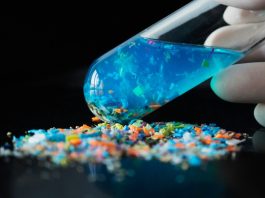The European Union has announced strong new measures to restrict the use of microplastics in a wide range of everyday products. EU Cracks Down. These rules are part of a bigger effort to fight plastic pollution and protect the environment, animal life, and human health.
Microplastics — tiny pieces of plastic less than 5 millimeters in size — are found in products such as cosmetics, cleaning products, fertilizers, paints, and even sports fields. These particles often end up in rivers, oceans, and soil, where they do not break down and can cause serious harm to wildlife and ecosystems.
Why the EU Is Taking Action
Scientific research has shown that microplastics are not only polluting the environment but may also be affecting human health. Microplastic particles have been found in fish, drinking water, and even the air we breathe. They are believed to enter the human body through food, water, and inhalation, although the full impact on health is still being studied.

The European Commission, the executive body of the EU, has decided to act now to reduce the release of these harmful particles into the environment. The new restrictions are being introduced under the European Chemicals Regulation, known as REACH, and will apply across all EU member states.
What the New Rules Will Cover
The restrictions focus on microplastics that are intentionally added to products — not those created through wear and tear like car tires or synthetic clothes (which will be addressed through other strategies). The rules cover a wide range of products, including:
- Cosmetics: Many beauty and skincare products, such as face scrubs and glitter makeup, contain microplastics for texture or shine. These will be banned unless safe alternatives are used.
- Detergents and Household Cleaners: Some cleaning products use microplastics to improve scrubbing power or to thicken liquid formulas. These will now need to be reformulated.
- Fertilizers and Plant Protection Products: In agriculture, microplastics are sometimes used to help nutrients release slowly. These uses will also be restricted unless safer technologies are developed.
- Paints, Inks, and Sealants: Certain coatings and sealants contain microplastic particles that make them more durable. Companies will now need to find replacements or prove that these products do not release microplastics into the environment.
- Artificial Sports Fields: One of the biggest sources of microplastic pollution is the rubber granules used as infill in synthetic turf. These tiny pellets often wash into drains during rain or maintenance. The EU plans to phase out this type of material and promote natural or less harmful alternatives.
Gradual Implementation to Help Industry Adapt
To avoid disruption, the EU will introduce the new rules gradually. Some bans will take effect within the next year, while others may take up to eight years to be fully enforced. This gives manufacturers time to adjust and invest in new technologies.
For example, companies in the cosmetics industry will be given time to reformulate products using natural or biodegradable ingredients. Manufacturers of artificial sports surfaces will be given longer deadlines to phase out rubber infill and develop safer alternatives.
In cases where microplastics are essential and no immediate alternative is available, products may still be allowed under strict conditions. However, these products will need clear labeling and safe disposal instructions to prevent them from entering the environment.
Environmental and Health Impact
The European Chemicals Agency (ECHA), which helped draft the new rules, estimates that these measures will prevent the release of about half a million tons of microplastics into the environment over the next 20 years. This is a major step toward cleaner oceans, rivers, and soil.
The environmental damage caused by microplastics is well known. These tiny particles can be mistaken for food by fish and seabirds, causing internal injuries, reduced growth, or death. They can also carry harmful chemicals that stick to their surfaces, entering the food chain and potentially affecting human health.
By taking this action, the EU is not only reducing pollution but also protecting biodiversity, wildlife, and the safety of our food and water.
Industry Reaction and Innovation
Although some industries have expressed concern about the cost and difficulty of switching away from microplastics, many have also welcomed the move as a necessary step for sustainability. Several companies have already started using natural exfoliants like ground nutshells, salt, and sugar in skincare products, and sports turf makers are developing biodegradable infill materials made from cork, coconut, or olive pits.
The European Commission is also encouraging innovation by funding research into safer alternatives and providing support for small businesses adapting to the new rules.
A Global Example in the Fight Against Plastic Pollution
This action is part of the EU’s larger plan to lead the global fight against plastic waste and move toward a circular economy — a system where products are reused, repaired, and recycled rather than thrown away.
Under the European Green Deal, the EU has committed to becoming climate-neutral by 2050 and drastically reducing pollution in all forms. Tackling microplastics is a key piece of this puzzle.
The EU hopes that by taking the lead, it will encourage other countries and regions to adopt similar rules. Some nations, like Canada and the United Kingdom, have already banned microbeads in certain cosmetics, but the EU’s new regulation is much broader and more detailed.
What’s Next?
The European Commission will closely monitor how the new rules are applied and update them if needed. It will also continue studying the impact of microplastics and exploring new ways to prevent pollution from sources not yet covered by these rules — such as tire dust and synthetic clothing fibers.
This landmark decision marks one of the most ambitious steps taken by any government in the world to tackle the growing problem of microplastic pollution.
As Europe takes bold action, the message is clear: the tiny particles we once ignored are now receiving big attention — and the days of using harmful microplastics in everyday products are numbered.



